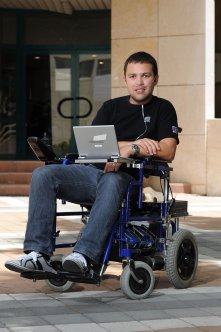A new device lets the disabled move and communicate with their noses.

The key to restoring movement and communication for the severely disabled may lie on the roofs of our mouths. Researchers have invented a device that allows the paralyzed to write, surf the Web and steer an electric wheelchair—all by sniffing. Initial tests, described recently in Proceedings of the National Academy of Sciences USA, suggest that patients with severe paralysis may soon have a new way of doing everyday tasks.
Sniffing is controlled in part by cranial nerves in the soft palate, the tissue lining the back of the roof of the mouth. Because these nerves emerge directly from the brain, as opposed to the spinal cord, they remain intact for many severely paralyzed people. They also control the ability to blink, sip and puff.
The sniff controller, which was developed by Anton Plotkin and his colleagues at the Weizmann Institute of Science in Rehovot, Israel, uses a small plastic tube that fits into the nose. It measures pressure, translating variations in intensity and frequency of sniffing in and out into commands for a computer or wheelchair.
In the study, the researchers tested the controller on 15 disabled patients; 13 used the technology to write messages or surf the Web and one to maneuver his wheelchair. (The 15th volunteer made no progress.) Further testing is required, but Plotkin is optimistic: “We figured out that sniffing can control just about anything.”
